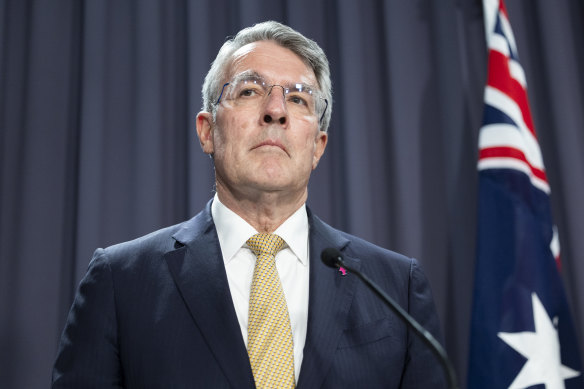This was published 8 months ago
Top public servant gets 20 per cent pay rise to $710,000
One of the nation’s top public servants has earned a 20 per cent pay bump, pushing her annual package from $592,250 to $710,700.
Director of Public Prosecutions Raelene Sharp, KC, received the hike after Attorney-General Mark Dreyfus wrote to the independent Remuneration Tribunal to assist in its pay review, meaning the senior public servant earns almost double of what a cabinet minister is paid.

Attorney-General Mark Dreyfus wrote to the Remuneration Tribunal about Raelene Sharp’s pay.Credit: Alex Ellinghausen
In comparison, employees of the public service, who are part of the Australian Public Service Commission Enterprise Agreement, will receive a 4 per cent pay rise this year, 3.8 per cent from March 2025 and 3.4 per cent from March 2026.
Public servant pay has come under recent scrutiny after it was revealed in Senate estimates this month that speechwriter Julianne Stewart was contracted at $620,000 over two years for Services Australia but spends the majority of her time writing speeches for Bill Shorten.
The Remuneration Tribunal is responsible for determining pay, allowances and entitlements of key Commonwealth office holders including judges of federal courts, most full and part-time holders of public offices and politicians.
It is an independent statutory body, whose tribunal members determine rates of pay.
Australian Prudential Regulation Authority chair John Lonsdale, who oversees regulation of the Australian financial services industry, receives $947,590 – the highest base salary of any Commonwealth public servant – followed by Australian Public Service Commissioner Gordon de Brouwer on $879,480.
In an amendment published on June 7, the tribunal states that Mark Dreyfus wrote to the statutory body on April 24 seeking a review of Sharp’s pay.
“The accompanying submission outlined changes to the role and responsibilities of the office,” the explanatory statement from the tribunal said.
As part of Sharp’s increased responsibilities, the office of the Director of Public Prosecutions received a $35 million funding boost over two years in the May budget to improve its capacity to undertake criminal prosecutions.
“The government strongly supports a well-resourced and capable Commonwealth Director of Public Prosecutions which is responsible, on behalf of all Australians, for prosecuting some of the most serious criminal offences including terrorism, people smuggling and child sexual abuse,” a spokesperson for Dreyfus said.
The latest remuneration declaration for all holders of full-time public office published in April shows 39 senior public servants are paid more than Prime Minister Anthony Albanese, who has a base wage of $586,930.
Current cabinet ministers, including Dreyfus, have a base salary just above $389,000. There are 109 public servants who earn more than cabinet ministers, including Australian Fisheries Management Authority chief executive officer Wez Norris, and Parliamentary Workplace Support Service chief executive Leonie McGregor, who each receive $444,210.
There are 189 senior public servants who are paid more than backbench MPs (who receive a base salary of $226,000). Those who earn more include Old Parliament House director Stephanie Bull, who is paid nearly $385,000 a year.
A spokesperson for the Remuneration Tribunal said a range of factors went into determining the pay of senior public servants, politicians and judges, and submissions for pay could be initiated either by the relevant minister, or by the tribunal.
“[The tribunal] may consider information including, but not limited to, the workload and work value of the office, remuneration in the private sector, wage indices, other economic indices, and remuneration for other offices in the tribunal’s jurisdiction,” the spokesperson said.
Beyond the pay of senior bureaucrats, reform of the Australian Public Service has been high on the agenda since Labor came into government. Data from the APS Employment Database shows the public service labour force has increased by 9.9 per cent from 2022 to 2023.
In comparison, Australian Bureau of Statistics data shows Australia’s labour force increased by 2.8 per cent in the same period.
Public Service Minister Katy Gallagher has defended the increase, arguing that the Coalition government suppressed public service numbers, while hiring 53,000 contractors, labour hire and consultants costing $21 billion.
“We are investing in critical service delivery areas and driving efficiencies to support a sustainable, capable public service. We are achieving $4 billion in savings from external labour, converting 8800 roles from external labour to public servants,” Gallagher said.
“The government is improving service delivery across Services Australia, DVA, NDIA and the ATO and investing to secure our region, build resilience and protect Australians, with the public service having a significant role to play in delivering AUKUS for example.”
An extra $6.5 billion in the May budget was allocated to entitlements for defence veterans, which the government said was “largely due to more claims being processed because of increased staffing levels”. About 60,000 cases had been left unallocated under the Coalition government due to a lack of public servants, it said.
Coalition public service spokeswoman Jane Hume said it was important that Australia maintain its “world-class public service” but criticised the government for investing more during a cost of living crisis.
“Labor has bloated the public service by 36,000 since they were elected. That’s almost 50 new bureaucrats each and every day, but no one in government can explain what taxpayers are getting for their money,” she said.
“The cost of these new public servants to the budget will be in the billions of dollars. That is money that could have been spent on essential services or used to pay down debt to reduce inflation.”
Cut through the noise of federal politics with news, views and expert analysis. Subscribers can sign up to our weekly Inside Politics newsletter.